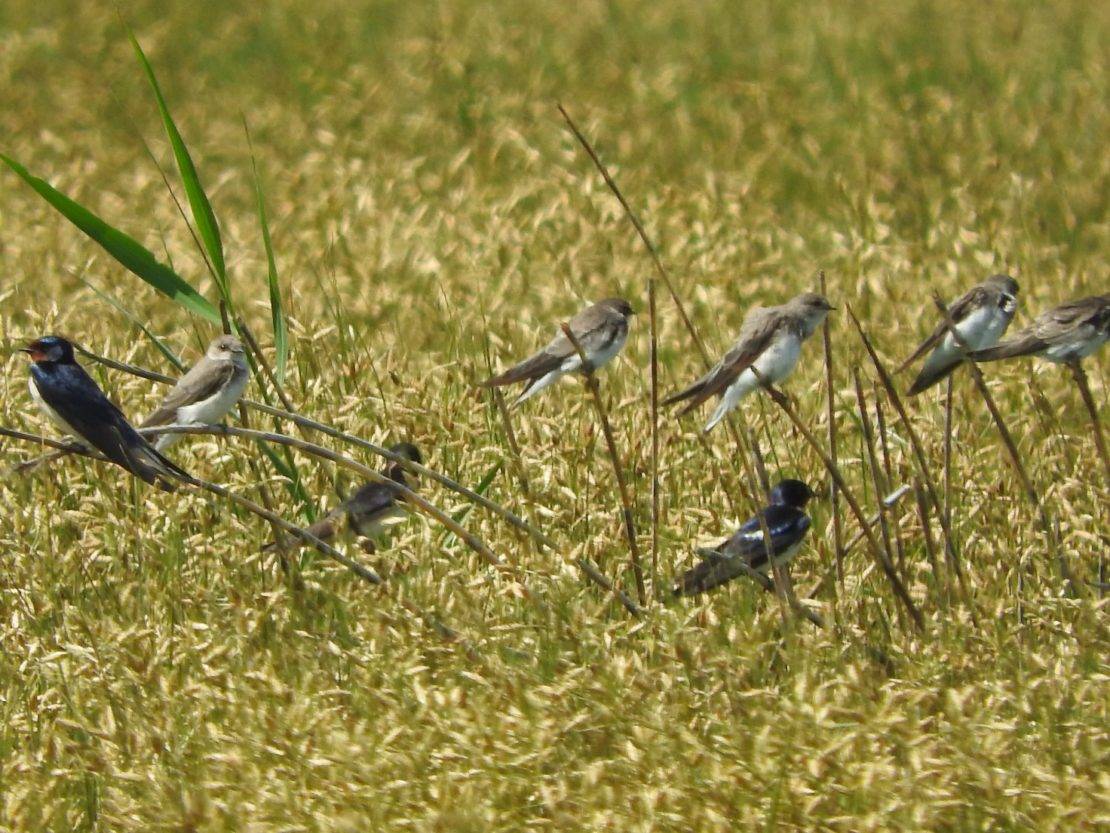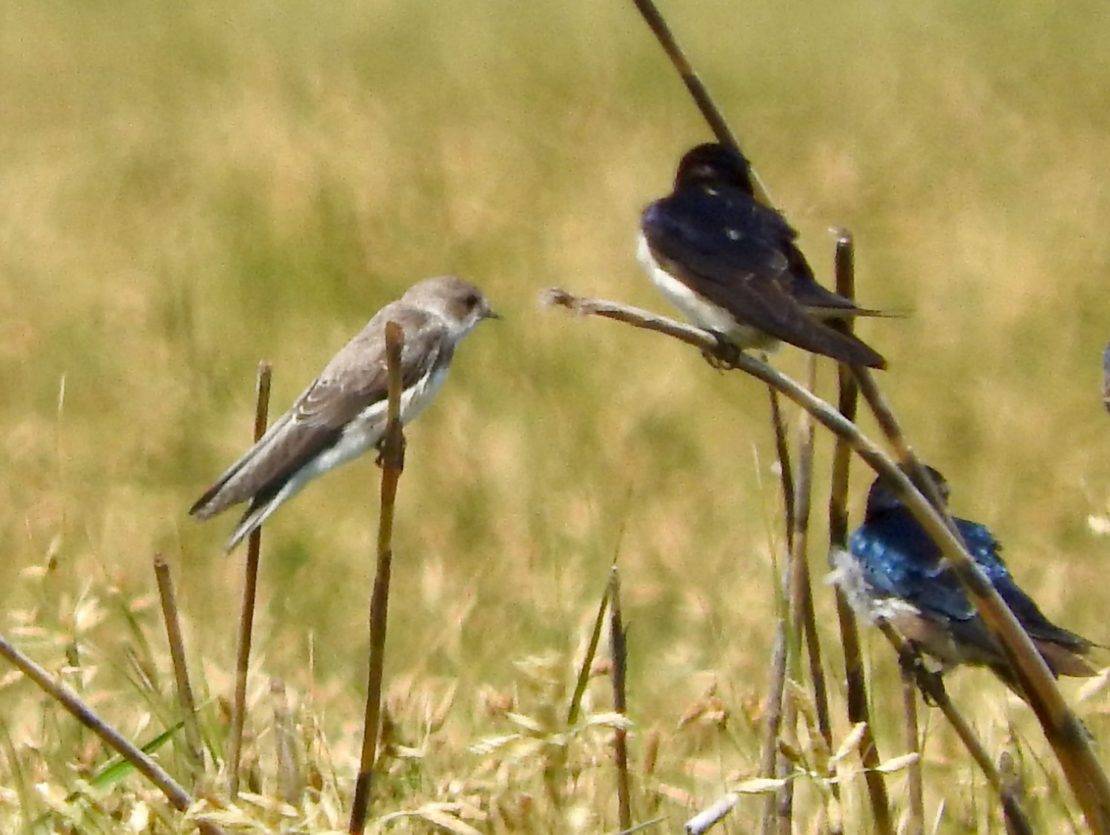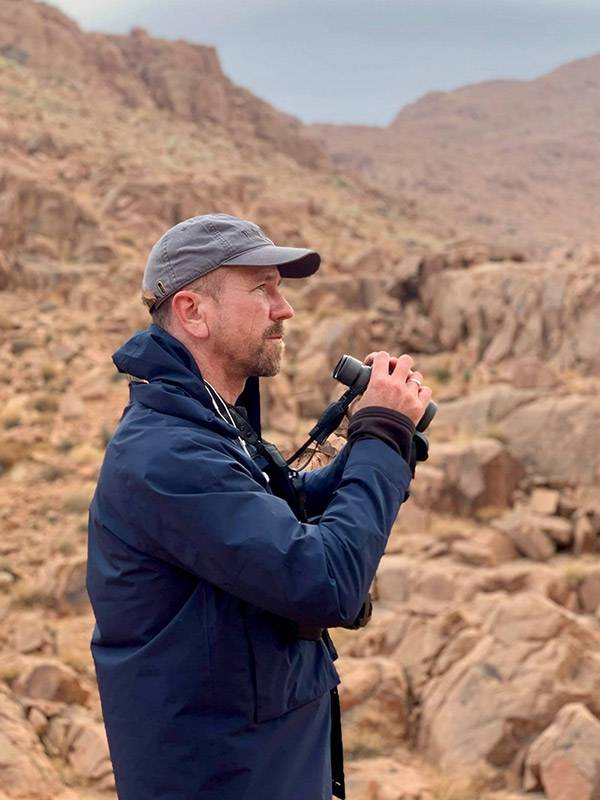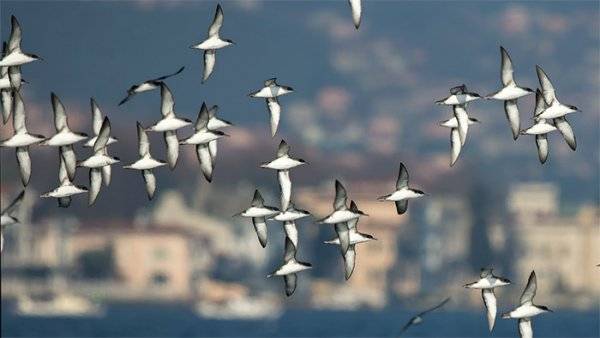A guest blog by Gregory Askew
On January 15, my daughter and I were out at Al Asfar Lake in Al Ahsa, in eastern Saudi Arabia conducting the first of a series of shorebird surveys for 2021. Scanning an expanse of marsh to the east of the lake proper, we spied a Golden Jackal moving through the sedge, my second encounter of the winter. Further on, in a gathering of Barn Swallows over 420 meters out, there were a few Riparia, one of which looked good for a Pale Martin Riparia diluta, an uncommon to rare winter visitor to the UAE and Oman from Central Asia. On account of the unfavorable distance and the fact we had a survey to finish—a slog of an endeavor given the sheer number of shorebirds around—we carried on our way. I was struck then, however, by the thought that Pale Martin may have wintered at the lake, as I first encountered the species there the end of October and then again every subsequent week after for nearly a month. On October 30, 2020, I found a pale Riparia species but only managed some low-quality shots of the bird as it perched on some loose reed stems with a few Barn Swallows. I observed it at length through my scope, however, and noted light-brown underwings, which the Birds of the Middle East—the only regional field guide—mentions as one of the key field marks (Porter & Aspinall 2010). Owing to less than satisfactory images, I returned the following weekend and relocated a similarly pale Riparia. This time, however, it seemed that there were two in the larger flock of Hirundines. To make sure I had enough frames to support the identification, I shot only video, paying special care to capture the underwings. The flock was even farther away than the previous weekend, but the footage strengthened my initial ID. There were a couple Sand Martins Riparia riparia present this time as well, showing dark-brown upper parts, breast-bands, and underwings for comparison.


I subsequently returned to the lake, twice more, found what I was now confident were Pale Martins, and captured even more footage. By and by, I had gathered enough that Dr. Manuel Schweizer, an expert on the species from The Natural History Museum of Bern to whom I reached out, confirmed them as Riparia diluta. The only other record of Pale Martin from Saudi Arabia came from Richard Meinertzhagen in 1948 near Mecca; however, according to Guy M. Kirwan and Andrew Grieve in their 2013 paper, this record had been “largely ignored in subsequent literature” on the species’ occurrence in Arabia and then ultimately proven by the authors, who examined the specimen among others from Meinertzhagen at The Natural History Museum at Tring in the UK, to be a misidentified Sand Martin. That means the birds out at Al Asfar Lake represent the first confirmed record of the species in Saudi Arabia.
Dr. Schweizer and Raffael Aye’s article “Identification of Pale Sand Martin Riparia diluta in Central Asia” was particularly instructive in helping me build the case for their identification. Initially three field marks, those mentioned in the Birds of the Middle East (see below for literature cited), led me to think these were Pale Martins out at the lake—light gray-brown upper parts, diffuse and partial breast bands, and light-brown underwings. However, according to Schweizer and Aye, dark eye sockets and lores contrasting with a pale forehead, crown, nape and pale ear-coverts that shade gradually into the white throat are more reliable features for diluta. While there are subtler differences between diluta and riparia, such as wing length and tarsal feathering, this suite of field marks proved critical for clinching the ID of the Riparia at Al Asfar Lake, especially given the challenging conditions.
The biggest challenge I faced in identifying them was the ever-increasing distance between my position on a utility road on the southern edge of the marsh and the patches of loose reeds where the swallows were gathering. After the first two weekends, subsequent observations were made at no less than 400 meters, which, in the good light of early morning, was just manageable through my 60x spotting scope at full zoom. However, my images and videos, while retaining reasonable color fidelity and ultimately enough detail to clinch the ID, lacked the finer definition they’d need to be considered even remotely “good”. When my daughter and I found the Riparia again this past January, I resolved to address the one thing that had vexed all my previous attempts at better images—the distance—and the only way to do so? Get a pair of waders!
After buying a pair, Adam Harris and I went out on January 22, but strong northerly winds kept most birds hunkered down as it appeared. Either way, the swallows weren’t about. I went back out on Friday, January 29, by myself and this time found the swallow flock in the same place my daughter and I had seen them two weeks prior, a few Riparia in the mix. I excitedly got on my gear and started cutting a beeline straight out across the marsh towards the patch of loose reeds where the swallows would return to perch and preen between feeding forays. About half way out I set up the scope and scanned the flock. Just to the left of about a dozen and a half Barn Swallows were two good candidates for Pale Martin. I got within 30 meters of the spot and then waited. Two hours later and only the Barn Swallows were returning to the patch. The Riparia were nowhere to be seen. I went back the next day, hoping that I might have simply disturbed them and they’d return. This time, despite nice conditions in the morning, all of the swallows, barring two Barns, appeared to have cleared out. It was frustrating, but so it goes.
Then on February 12, while conducting the second shorebird survey out at the lake, I spotted an even larger flock of Riparia along with about two dozen Barn Swallows in the same spot as before. This was my chance. I pulled my waders on, grabbed my gear, and tromped out once again. This time I was able to approach quite close. Among the Barn Swallows, there were around 10 to 12 Pale Martins along with a few Sand Martins. The flock was quite active and flighty, but I was able to capture more video footage and images at a distance that revealed them to be unquestionably diluta. The Pale Martinswere molting their flight feathers and preening feverishly, which may have been why they were more obliging this time.
I returned the following weekend, when the area was experiencing a rare spot of weather, and again found the Riparia absent. I ran into Jem Babbington and Phil Knight on my way back to the road. After a brief chat, they donned their waders and went out but had no luck as well. This was the second time the swallows were nowhere to be seen, suggesting that inclement weather might force them to lay low or disperses them across a wider area, only to return once the conditions clear.
My last encounter with the Pale Martins out at the lake was on February 26. Again I found a larger gathering of them—perhaps around 10 birds—and approached fairly close to where they were perching. The birds stayed closer to the spot when out flying and I carefully observed key features that were harder to pin down while perched, such as the structure of the tail. The few Sand Martins around were clearly larger in flight and showed a markedly forked tail, while the tail on the Pale Martins often appeared more squared with a slight notch towards the center when folded. The Pale Martins were also the most vocal, and, despite windy conditions, I managed this time to record their calls as they wheeled about the area between periods of rest at the reed patch.
I don’t think I’ve ever worked so hard to confirm an ID before, but thankfully the Pale Martins spent the winter out at Al Asfar Lake, giving me ever-improving opportunities. Given Pale Martin’s status as an uncommon to rare winter visitor to the UAE and a 2017 first record from Kuwait (Craig et al 2017), chances are they’ve been overlooked in the Eastern Province over the years. With the Kingdom’s first confirmed record, I’m sure there will be more to come.

Originally from Northeastern United States, Gregory Askew has been living and working in the Middle East since 2010. He currently works as an Advanced ITC Instructor at Aramco’s Industrial Training Center in Al Ahsa, where he lives with his wife, Michelle, a visual artist. You may find him birding at one of his haunts around Al Ahsa—Al Asfar Lake, Jebel Al Qarra, or Al Ahsa National Park—or maybe further afield in the mountains and wadis of the Asir Region.
LITERATURE CITED
Askew, G. [Saudi Birding]. 2021. Birds of Saudi Arabia: Pale Sand Martins (February 12, 2021) [Video]. YouTube. https://www.youtu.be/jpla2ctcMh4.
Askew, G. 2021. Xeno-canto sound recording XC625016. https://www.xeno-canto.org/625016.
Birds of Kuwait. 2017. Kuwait Ornithological Rarities Committee. https://www.birdsofkuwait.com/korc-page/. [Accessed 8 March 2021]
Kirwan, G & A Grieve. 2013. Unravelling Meinertzhagen-generated confusion concerning the occurrence of Pale Sand Martin Riparia diluta in Egypt and the Near East, with a review of the species’ status in the Middle East. Sandgrouse 35: 114 – 125.
Porter, R & S Aspinall. 2010. Birds of the Middle East. 2nd ed. Princeton University Press, USA.
Saudi Birding. 2021. ID Challenges: Pale Sand Martin vs. Common Sand Martin. https://saudibirding.com/2021/02/02/pale-sand-martin-vs-common-sand-martin/
Schweizer, M and R Aye. 2007. Identification of the Pale Sand Martin Riparia diluta in Central Asia. Alula 4: 152 – 158.


